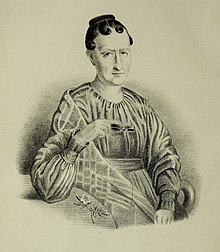Marie-Anne Libert
Marie-Anne Libert (born April 7, 1782 in Malmedy ; † January 14, 1865 there ) was a Belgian mycologist . Your official botanical author abbreviation is " Lib. ". According to her is Iris genus Libertia named.
Life
Marie-Anne Libert was born the 11th of 12 children to a wealthy family of tanners . She did her first training at the local school of the Sepulchrines , at the age of 11 she went to a boarding school in Prüm to better learn the German language and to play the violin. Thanks to her general talent, her father taught her algebra and geometry , in the hope that she could later take over the family business. She learned the Latin language in self-study. Thanks to her great thirst for knowledge, she had a wide range of interests, such as nature, but also archeology in the area of the Imperial Abbey of Stablo-Malmedy . She studied the flora and fauna of her homeland, which also includes the High Fens . In the course of time she put together a large collection of pearls that came from the river and pond mussels from the various streams of her homeland, as well as an extensive collection of coins. In addition to her natural science inclinations, she and her brothers led the family's inherited tannery to great prosperity.
Botanical work
She was the first to describe various phytopathogenic sac fungi , including Alternaria cheiranthi (Lib.) PC Bolle (as Helminthosporium cheiranthi ) and Fusarium coeruleum Lib. Ex Sacc. In 1839 she became an honorary member of the Botanical Association on the Middle and Lower Rhine . At times she worked with the doctor and biologist Alexandre Lejeune from neighboring Verviers , who had the public contract to create a botanical catalog of the Ourthe department . She bequeathed her extensive herbarium to the botanical gardens of the Belgian state .
Honors
- In 1862 she became the first female member of the Société Royale des sciences Botaniques de Belgique .
- The city of Malmedy named a park after her, the Parc Marie-Anne Libert in which a stele commemorates her, and a street in her hometown was named after her.
Web links
- Author entry and list of the described plant names for Marie-Anne Libert at the IPNI
- LIBERT Marie-Anne on connaître la Wallonie
literature
- Heinz Warny: Pictures of Life from Ostbelgien (Volume 2, pp. 128–129). ISBN 978-3-86712-146-0 .
Individual evidence
- ^ Marie-Anne Libert in the Index Fungorum
- ↑ Philipp Wirtgen : The botanical association on the Middle and Lower Rhine . In: Flora or general botanical newspaper, 21, 1841, p. 331 digitized
- ↑ Biographical information on the website of the Cercle Marie-Anne Libert (in French)
| personal data | |
|---|---|
| SURNAME | Libert, Marie-Anne |
| ALTERNATIVE NAMES | Libert, Marie Anne; Lib. (Botanical author abbreviation) |
| BRIEF DESCRIPTION | Belgian mycologist |
| DATE OF BIRTH | April 7, 1782 |
| PLACE OF BIRTH | Malmedy |
| DATE OF DEATH | January 14, 1865 |
| Place of death | Malmedy |
